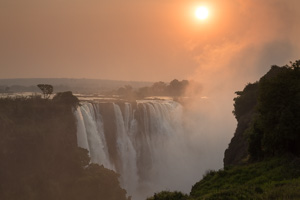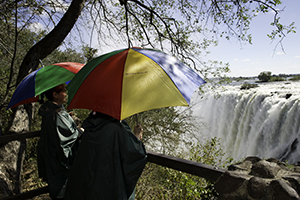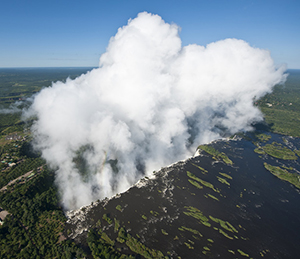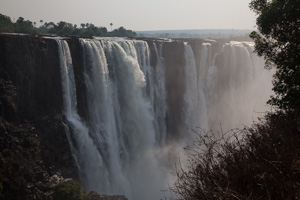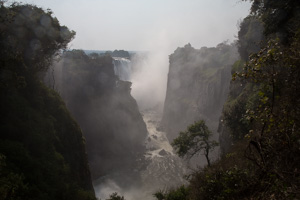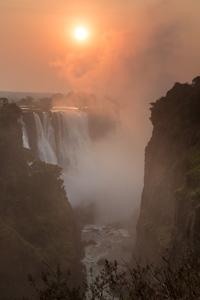
|
||
Photographing Victoria Falls - Part I
The Mist. Even when the Falls are at their lowest, there is a soaking mist that envelopes all the best vantage points. Either have a waterproof cover for your camera, or carry it under your raincoat. Take several tissues and a lens cloth in a plastic Ziplock bag to keep your lens dry: use tissues to soak most moisture from the lens, and then finish it off with the lens cloth. Plan your shots while you wait for the swirling wind to create a brief opening in the mist, then move quickly to take some shots.
High Water. The Falls are typically at full flood from March through June, shaking the earth and creating a thick plume of mist that can be seen from many miles away. Photographic opportunities are roughly equivalent on the Zambian and Zimbabwe sides (albeit that Zimbabwe has more lookout points). The mist is a constant challenge for ground level shots, but this is a great time for aerial photography: helicopter flights are offered from both the Zimbabwe and Zambian side of the Falls, offering a full 360 degree perspective. Microlight flights are fun and exciting, but cameras and other loose objects are not permitted (photos are offered for sale from a wing-mounted camera).
Low Water. From October to December the Falls are at their lowest, and viewing is best on the Zimbabwe side - focus on Devil's Cataract and Main Falls. There is no water on the Zambian side, but one advantage is that Zambia provides access to Livingstone Island and the infamous Devil's Pool at low water. Mist is still a challenge at the best vantage points, but much easier to manage. Aerial photography is least rewarding at this time.
Vantage Points. There are nearly 30 vantage points from which to photograph the Falls, and each offers a somewhat different perspective. Most offer a backlit frontal view, but perhaps the most photographically interesting are those towards the two ends, offering profile or diagonal views along the length of the chasm. Viewpoint 2 on the Zimbabwe side features steps leading down about 50' to a landing that offers a more upward-facing perspective of the Falls.
Sunrise, Sunset. The Falls are open to the public from 6am to 6pm, and the first and last hour of light provide the most dramatic photo opportunities. The profile view from the Zimbabwe side looks directly eastwards, making it best for sunrise shots; the profile view from Zambia faces west, and is best for sunset shots. From October through February, sunrise and sunset may fall outside Park hours (6am to 6pm), but beautiful shots of the fiery sun hanging over the Falls just above the horizon are still possible. What about the famous rainbows? What gear should I take? How do I convey the scale of the Falls? These are some of the subjects that will be covered in the next exciting installment of Classic Africa News. Let us help you plan your dream safari. call toll-free: 888.227.8311 or email us today
|
||
|


